ALS: All Lies in Stem, Differentiating Stem Cells into Astrocytes and Targeting TDP-43 Protein Plaques in vivo

ALS: All Lies in Stem, Differentiating Stem Cells into Astrocytes and Targeting TDP-43 Protein Plaques in vivo
par Li Shu Yin Han, Emanuel Louis, Christina-Maria Maalouf, Wendy Yang
Année préparatoire de médecine, Université de Montréal
Amyotrophic lateral sclerosis (ALS) is a fatal neurodegenerative disease affecting 2 per 100,000 annually in the US, making it the most common motor neuron disease [1]. A prion-like mechanism underlies this ailment, involving oxidation and structural damage of the 43-kDA TAR DNA-binding protein (TDP-43), which accumulates as protein aggregates in astrocytes [2]. Consequently, astrocytes in ALS lose neuroprotective property and acquire toxic phenotypes [3]. Stem cells have been shown to reduce amyloid plaques in prion diseases [4]. We will assess its regenerative abilities to halt the disease progression by replacing the diseased astrocytes with in vitro differentiated stem cells and examine the possibility of eliminating TDP-43 aggregates with stem cells. Therapeutic astrocytes will be differentiated in vitro from bone marrow-derived mesenchymal stem cells that are bromodeoxyuridine-labelled and then transplanted into ventral horns of ALS mice models [5]. Their brains will be harvested and sectioned, then prepared with paraformaldehyde for immunohistochemistry. Astrocyte in vivo migration will be monitored by the presence of the rabbit-sourced glial fibrillary acidic protein GFAP marker on motor neurons [6]. The elimination of TDP-43 plaques will be visualized by using fluorescent-labeled, rabbit-sourced anti-TDP-43 antibodies. We expect a reduction of labelled TDP-43 in mice neurological samples, indicating the corresponding reduction of protein aggregates, as suggested by the previous analysis of affected homogenate using immunofluorescence [4]. These findings seek to show that stem cells constitute a possible future avenue for the treatment of ALS, which may save the lives of many patients living through this debilitating disease and alleviate the disease burden worldwide.
Key words : ALS, immunohistochemistry, TDP-43, astrocytes, stem cell
Références
1. Zarei, S. et al. A comprehensive review of amyotrophic lateral sclerosis. (2015). Available at: https://www.ncbi.nlm.nih.gov/pmc/articles/PMC4653353/. (Accessed: November 2020)
2. Lee, S. & Kim, H.-J. Prion-like Mechanism in Amyotrophic Lateral Sclerosis: are Protein Aggregates the Key? Experimental neurobiology (2015). Available at: https://www.ncbi.nlm.nih.gov/pmc/articles/PMC4363329/. (Accessed: November 2020)
3. Nagai, M. et al. Astrocytes expressing ALS-linked mutated SOD1 release factors selectively toxic to motor neurons. (2007). Available at: https://www.nature.com/articles/nn1876. (Accessed: November 2020)
4. Krejciova, Z. et al. Human embryonic stem cells rapidly take up and then clear exogenous human and animal prions in vitro. Wiley Online Library (2011). Available at: https://onlinelibrary.wiley.com/doi/abs/10.1002/path.2832. (Accessed: November 2020)
5. Ciervo, Y., Ning, K., Jun, X., Shaw, P. J. & Mead, R. J. Advances, challenges and future directions for stem cell therapy in amyotrophic lateral sclerosis. Molecular neurodegeneration (2017). Available at: https://www.ncbi.nlm.nih.gov/pmc/articles/PMC5683324/. (Accessed: November 2020)
6. Smethurst, P. et al. Distinct responses of neurons and astrocytes to TDP-43 proteinopathy in amyotrophic lateral sclerosis. OUP Academic (2020). Available at: https://academic.oup.com/brain/article/143/2/430/5732965. (Accessed:November 2020)





